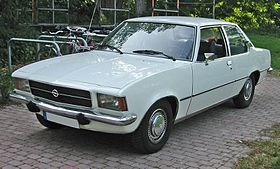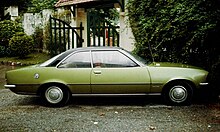| Opel Rekord Series D | |
|---|---|
 | |
| Overview | |
| Manufacturer | Opel (General Motors) |
| Production | 1972–1977 |
| Assembly |
|
| Body and chassis | |
| Class | Large family car (D) |
| Body style | |
| Related | Opel Commodore B |
| Powertrain | |
| Engine | |
| Transmission | 4-speed manual column shift ("Sportschaltung" floor mounted shift optional on petrol powered versions) 3-speed automatic optional |
| Chronology | |
| Predecessor | Opel Rekord Series C |
| Successor | Opel Rekord Series E |





The Opel Rekord D series is a large family car that replaced the Rekord C on Opel's Rüsselsheim production lines during the closing weeks of 1971[1] and launched on the West German market at the start of 1972. It shared its wheelbase and inherited most of its engines from its predecessor, but the bodies were completely new. Also new, announced in September 1972, was the option of a diesel powered Opel Rekord. Early advertising and press material called the new car the "Opel Rekord II" but in due course, the "Rekord II" appellation was quietly dropped and the Rekord D was replaced at the end of the 1977 summer holiday shut down by the Opel Rekord E.
The Rekord D's 5½ year production run was longer than that of any previous generation of Opel Rekord: during that period 1,128,196 were produced. It was the second Opel Rekord to exceed the million mark, although its final year saw a marked decrease in demand, as the car was challenged from below after 1975 by the second generation Opel Ascona. By now the increases in fuel prices were encouraging middle market customers to downsize, at a time when the Opel Rekord had, over the years, grown to occupy a market slot at the top end of the "medium-sized" category in northern Europe, being already seen as a "large" family car in Italy and France.
Various cars based on the Rekord D were also built at General Motors plants outside West Germany, both within and beyond Europe.
- ^ Zink, Günther, ed. (2009). Oldtimer Katalog (in German). Vol. 23. Königswinter: HEEL Verlag GmbH. p. 263. ISBN 978-3868520675.